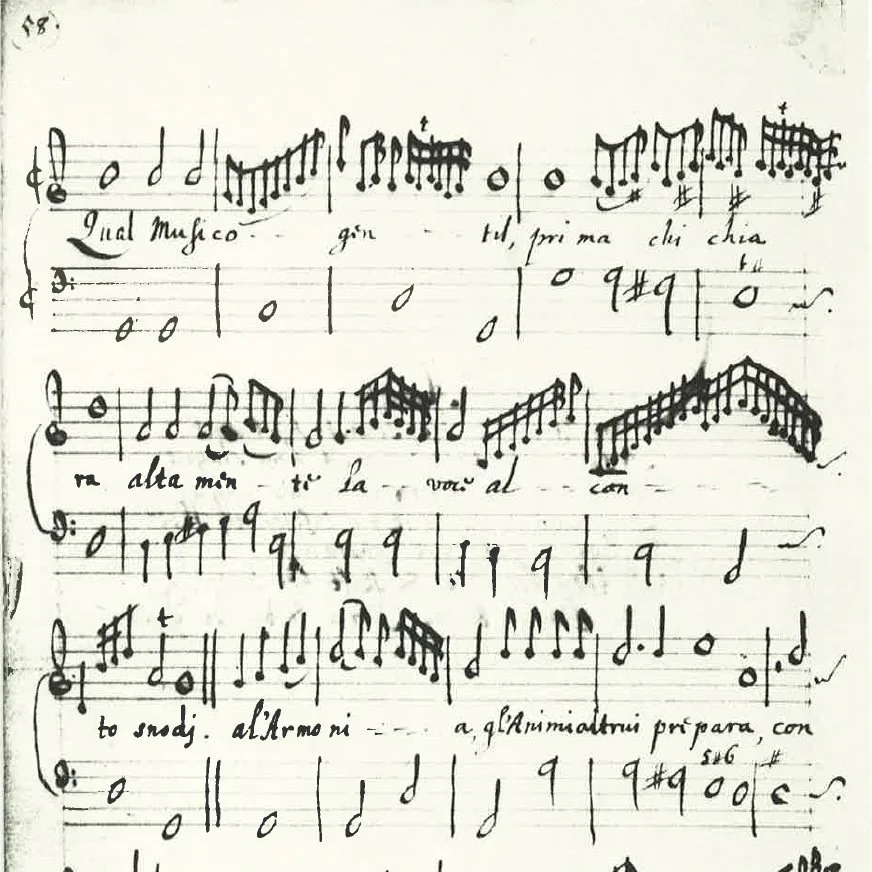The British Library Add MS 11608: A Source of 17th Century English Songs and Ornamentation
The British Library Add. MS 11608 is one of the largest and most important sources of mid-seventeenth-century English songs, particularly for the details it provides on vocal ornamentation, comprising over seventy songs and dialogues, as well as 3-part catches, compiled between 1652 and 1660. It is considered the most significant source for English ornamented song, showcasing the full development of English vocal divisions in the middle of the 17th century.
"The Music Lesson" by Johannes Vermeer, painted c. 1662–1665.
Oil on canvas housed at the Queen's Gallery in London.
The manuscript contains a few Italian songs, and as in Egerton 2971 and Add. 29481, these are among the most highly ornamented songs in the collection. There is also an interesting Italian setting by Nicholas Lanier, ⏵︎ “Qual musico gentil” (f.27v). In this song, the basic melodic outline is very simple, supported by the most rudimentary of basses. The piece relies almost entirely on ornamentation, with divisions that are extended and cover a very wide compass, combining virtuosity with the quality of fluidity and grace characteristic of the Italian style.
"Qual musico gentil" set by Nicholas Lanier. From Add. MS 11608, ff. 27v.
Text from Torquato Tasso’s Canto XII of his epic poem "Gerusalemme Liberata" (Jerusalem Delivered), first published in 1581.
The manuscript also contains English songs with highly ornamented vocal divisions, such as Robert Johnson's “Care-charming sleep,” and ⏵︎ “Woods, rocks and mountains,” Thomas Brewer's "O that mine eyes," and John Wilson's "Take, o take those lips away." The divisions in these songs, influenced by Italian models, are expressive in a restrained English tradition, making them less spectacular than Italian models but more likely to convey intense emotion. The florid style of divisions is not restricted to the Italian settings but is also found in many of the English songs.
Of these four songs, ⏵︎ “Care-charming sleep” is the most florid, with divisions forming elaborate arabesques around the basic melodic outline. The notation of the rhythm is only approximate, and a value of a crotchet is often ornamented with seven or nine semiquavers. The ornamentation is not pictorial, but the divisions are expressive in a general sense. This is particularly well illustrated in the passionate sacred song ⏵︎ “O that mine eyes,” in which the divisions greatly increase the overall intensity of the song.
"Care-charming sleep", a song in The Tragedy of Valentinian by Beaumont & Fletcher, 1647.
Set to music by Robert Johnson, Add. MS 11608, ff.16v-17r.
Although the divisions are highly florid, they are used sparingly. ⏵︎ “Take, o take those lips away,” for example, gives only five or so divisions in the first verse, with a few alternative divisions for the second verse, and the most florid ornamentation of all is reserved for the final cadence of the song.
The manuscript gives the impression of being a book for immediate use by several people, a working copy. This impression is created by the various ornamented versions of a single passage at the end of a song, and the existence of more than one hand in the entry of these passages.
The folio 77r of Add. MS 11608 provides four variants 'as Mr. Elliston sings it' of final cadences for the close of the last verse of Nicholas Lanier’s ⏵︎ “No more shall meads” (Love's constancy).
British Library, Add. MS 11608, fol. 77r.
Overall, Add MS 11608 is a valuable source for understanding English ornamented song and vocal divisions in the mid-17th century, showcasing the influence of Italian models and the distinct qualities of English expression in ornamentation.
References:
Chan, M. (1979). John Hilton's Manuscript British Library Add. MS 11608. Music & Letters, 60(4), 440-449. Oxford University Press. Stable URL: http://www.jstor.org/stable/733508
Huws Jones, E. (1987). The Performance of English Song: 1610-1670. Outstanding Dissertations in Music from British Universities. New York: Garland. Retrieved from https://www.proquest.com/scholarly-journals/performance-english-song-1610-1670-edward-huws/docview/129678139
Jorgens, E. B. (Ed.). (1986-1989). English Song, 1600–1675: Facsimiles of Twenty‐six Manuscripts and an Edition of the Texts. (Vol. 4: British Library Manuscripts, Part IV: Add. Ms. 11608; Add. Ms. 32339). New York: Garland Publishing, Inc.



